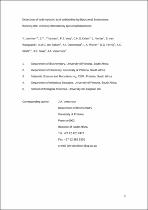JavaScript is disabled for your browser. Some features of this site may not work without it.
- ResearchSpace
- →
- Research Publications/Outputs
- →
- Journal Articles
- →
- View Item
| dc.contributor.author |
Lemmer, Yolandy

|
|
| dc.contributor.author |
Thanyani, ST

|
|
| dc.contributor.author |
Vrey, PJ

|
|
| dc.contributor.author |
Driver, CHS

|
|
| dc.contributor.author |
Venter, L

|
|
| dc.contributor.author |
Van Wyngaardt, S

|
|
| dc.contributor.author |
Ten Bokum, AMC

|
|
| dc.contributor.author |
Ozoemena, KI

|
|
| dc.contributor.author |
Pilcher, LA

|
|
| dc.contributor.author |
Fernig, DG

|
|
| dc.contributor.author |
Stoltz, AC

|
|
| dc.contributor.author |
Swai, HS

|
|
| dc.contributor.author |
Verschoor, JA

|
|
| dc.date.accessioned | 2011-05-05T12:36:16Z | |
| dc.date.available | 2011-05-05T12:36:16Z | |
| dc.date.issued | 2009 | |
| dc.identifier.citation | Lemmer, Y, Thanyani, ST, Vrey, PJ et al. 2009. Detection of antimycolic acid antibodies by liposomal biosensors. Methods in Enzymology, Vol. 464(Part F), pp 79-102 | en_US |
| dc.identifier.issn | 0076-6879 | |
| dc.identifier.uri | http://www.ncbi.nlm.nih.gov/pubmed/19903551 | |
| dc.identifier.uri | http://hdl.handle.net/10204/4983 | |
| dc.description | Copyright: 2010 Elsevier. This is the pre print version of the work. The definitve version is published Methods in Enzymology, Vol. 464(Part F), pp 79-102 | en_US |
| dc.description.abstract | Antibodies to mycolic acid (MA) antigens can be detected as surrogate markers of active tuberculosis (TB) with evanescent field biosensors where the lipid antigens are encapsulated in liposomes. Standard immunoassay such as ELISA, where the lipid antigen is not encapsulated, but directly adsorbed to the wellbottoms of microtiter plates, does not yield the required sensitivity and specificity for accurate diagnosis of TB. One reason for this is the cross-reactivity of natural anticholesterol antibodies with MAs. MAs are the major cell wall lipids of mycobacteria. Mycobacterial MA has immunomodulatory properties and elicits specific antibodies in TB patients. Liposomes were optimized for their use as carriers both for the presentation of immobilized purified mycobacterial MA on sensor surfaces, and as a soluble inhibitor of antibody binding in inhibition assays. By using an inhibition assay in the biosensor, the interference by anticholesterol antibodies is reduced. Here, we describe the MA carrying capacity of liposomes with and without cholesterol as a stabilizing agent, optimized concentration and size of liposomes for use in the biosensor assay, comparison of the methods for wave-guide and surface plasmon resonance biosensors and how the cholesteroid nature of MA can be demonstrated by the biosensor when Amphotericin B is allowed to bind to MA in liposomes. | en_US |
| dc.language.iso | en | en_US |
| dc.publisher | Elsevier | en_US |
| dc.relation.ispartofseries | Workflow request;3553 | |
| dc.subject | Mycolic acid | en_US |
| dc.subject | Tuberculosis | en_US |
| dc.subject | Liposomes | en_US |
| dc.subject | Mycobacterial | en_US |
| dc.subject | Enzymology | en_US |
| dc.subject | Biochemistry | en_US |
| dc.title | Detection of antimycolic acid antibodies by liposomal biosensors | en_US |
| dc.type | Article | en_US |
| dc.identifier.apacitation | Lemmer, Y., Thanyani, S., Vrey, P., Driver, C., Venter, L., Van Wyngaardt, S., ... Verschoor, J. (2009). Detection of antimycolic acid antibodies by liposomal biosensors. http://hdl.handle.net/10204/4983 | en_ZA |
| dc.identifier.chicagocitation | Lemmer, Yolandy, ST Thanyani, PJ Vrey, CHS Driver, L Venter, S Van Wyngaardt, AMC Ten Bokum, et al "Detection of antimycolic acid antibodies by liposomal biosensors." (2009) http://hdl.handle.net/10204/4983 | en_ZA |
| dc.identifier.vancouvercitation | Lemmer Y, Thanyani S, Vrey P, Driver C, Venter L, Van Wyngaardt S, et al. Detection of antimycolic acid antibodies by liposomal biosensors. 2009; http://hdl.handle.net/10204/4983. | en_ZA |
| dc.identifier.ris | TY - Article AU - Lemmer, Yolandy AU - Thanyani, ST AU - Vrey, PJ AU - Driver, CHS AU - Venter, L AU - Van Wyngaardt, S AU - Ten Bokum, AMC AU - Ozoemena, KI AU - Pilcher, LA AU - Fernig, DG AU - Stoltz, AC AU - Swai, HS AU - Verschoor, JA AB - Antibodies to mycolic acid (MA) antigens can be detected as surrogate markers of active tuberculosis (TB) with evanescent field biosensors where the lipid antigens are encapsulated in liposomes. Standard immunoassay such as ELISA, where the lipid antigen is not encapsulated, but directly adsorbed to the wellbottoms of microtiter plates, does not yield the required sensitivity and specificity for accurate diagnosis of TB. One reason for this is the cross-reactivity of natural anticholesterol antibodies with MAs. MAs are the major cell wall lipids of mycobacteria. Mycobacterial MA has immunomodulatory properties and elicits specific antibodies in TB patients. Liposomes were optimized for their use as carriers both for the presentation of immobilized purified mycobacterial MA on sensor surfaces, and as a soluble inhibitor of antibody binding in inhibition assays. By using an inhibition assay in the biosensor, the interference by anticholesterol antibodies is reduced. Here, we describe the MA carrying capacity of liposomes with and without cholesterol as a stabilizing agent, optimized concentration and size of liposomes for use in the biosensor assay, comparison of the methods for wave-guide and surface plasmon resonance biosensors and how the cholesteroid nature of MA can be demonstrated by the biosensor when Amphotericin B is allowed to bind to MA in liposomes. DA - 2009 DB - ResearchSpace DP - CSIR KW - Mycolic acid KW - Tuberculosis KW - Liposomes KW - Mycobacterial KW - Enzymology KW - Biochemistry LK - https://researchspace.csir.co.za PY - 2009 SM - 0076-6879 T1 - Detection of antimycolic acid antibodies by liposomal biosensors TI - Detection of antimycolic acid antibodies by liposomal biosensors UR - http://hdl.handle.net/10204/4983 ER - | en_ZA |






